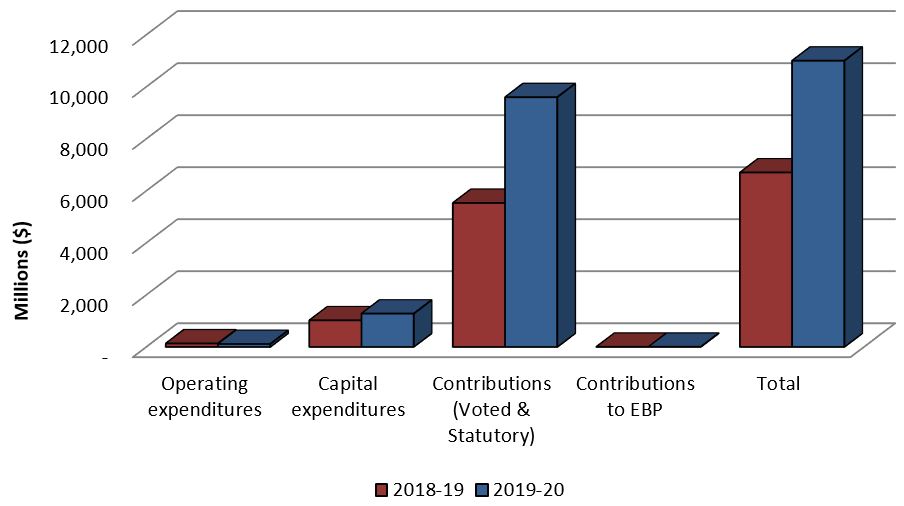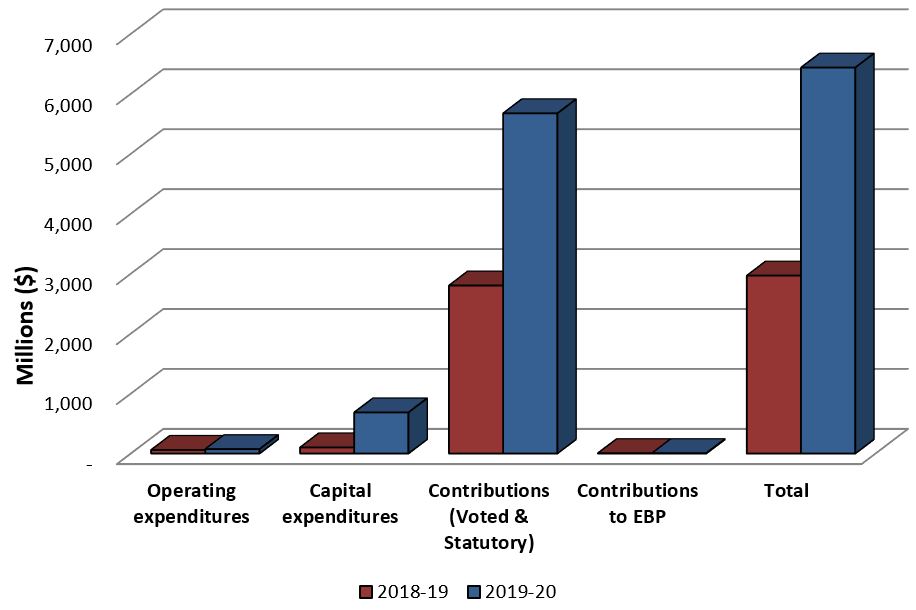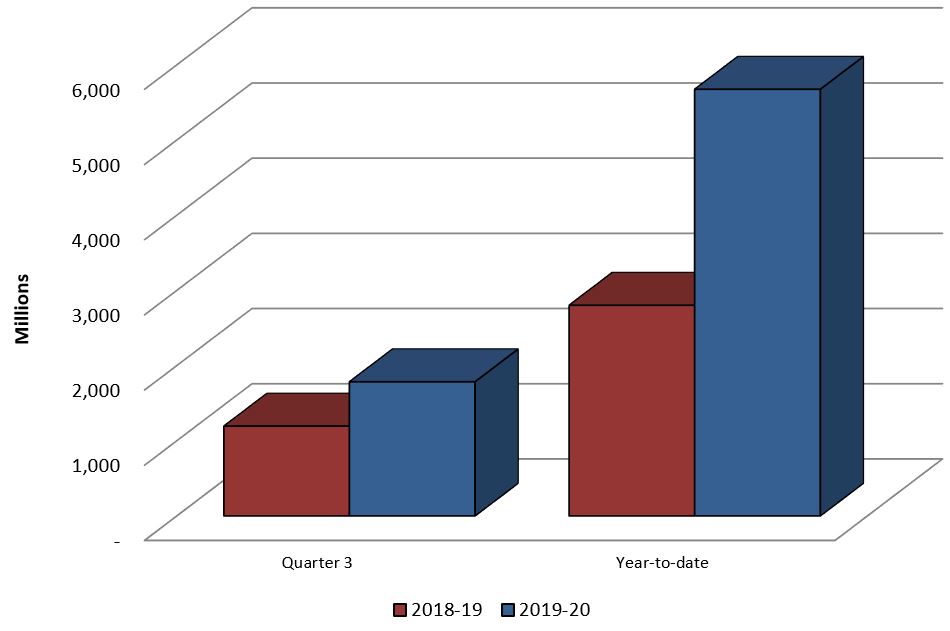Office of Infrastructure of Canada
Quarterly Financial Report for the quarter ended December 31, 2019
Statement outlining results, risks and significant changes in operations, personnel and programs
Introduction
This quarterly report has been prepared by management as required by Section 65.1 of the Financial Administration Act and in the form and manner prescribed by the Treasury Board. This quarterly report should be read in conjunction with the Main Estimates as well as Budget 2019.
The key to building Canada for the 21st century is a strategic and collaborative long-term infrastructure plan that builds economically vibrant, strategically planned, sustainable and inclusive communities. Infrastructure Canada (INFC) works closely with all orders of government and other partners to enable investments in social, green, public transit and other core public infrastructure, as well as trade and transportation infrastructure.
Further information on INFC's mandate, responsibilities, and programs can be found in INFC's 2019-20 Main Estimates.
Basis of Presentation
This quarterly report has been prepared by management using an expenditure basis of accounting. The accompanying Statement of Authorities includes INFC's spending authorities granted by Parliament and those used by INFC consistent with the Main Estimates and Supplementary Estimates for the 2019-20 fiscal year (FY). This quarterly report has been prepared using a special purpose financial reporting framework designed to meet financial information needs with respect to the use of spending authorities.
The authority of Parliament is required before monies can be spent by the government. Approvals are given in the form of annually approved limits through Appropriation Acts or through legislation in the form of statutory spending authority for specific purposes.
INFC uses the full accrual method of accounting to prepare and present its annual departmental financial statements that are part of the departmental performance reporting process. However, the spending authorities voted by Parliament remain on an expenditure basis.
In the past, INFC has worked in collaboration with other federal departments and agencies to deliver some of its transfer payment programs (collectively known as federal delivery partners).
During the third quarter of 2019-20, the only federal delivery partner for certain sunsetting programs was Transport Canada.
It should be noted that this quarterly report has not been subject to an external audit or review.
Highlights of Fiscal Quarter and Fiscal Year-to-Date Results
This section highlights the significant items that contributed to the change in resources available for use from 2018-19 to 2019-20 and in actual expenditures as of December 31, 2018 and December 31, 2019.
Authorities
Graph 1: Comparison of Authorities Available as of December 31, 2018 and December 31, 2019
As shown in the Statement of Authorities, INFC's total authorities available for 2019-20 are $11.008 billion as of the end of Quarter 3 (Q3) and represent a $4.300 billion increase compared to the same quarter in the prior year.
This increase is summarized in the table below:
|
Authorities |
Increase/(Decrease) |
% Change vs. prior year |
|---|---|---|
|
Operating Expenditures |
(23,928) |
(17.4%) |
|
Capital Expenditures |
257,889 |
25.2% |
|
Contributions (Voted and Statutory) |
4,066,443 |
73.4% |
|
Contributions to Employee Benefit Plans |
(895) |
(11.5%) |
The sources of significant year-over-year changes are summarized as follows:
- Operating Expenditures – The decrease is mainly due to a top-up amount the Samuel De Champlain Bridge Corridor project received in 2018-19 for contingency purposes through Supplementary Estimates A. In 2019-20, the project’s operating funds from 2018-19 have been re-profiled and are expected to be received through Supplementary Estimates B.
- Capital Expenditures – The increase is related to the milestone payments in fiscal year 2019-20 for the Samuel De Champlain Bridge Corridor project.
- Contributions (Voted and Statutory) – Voted contribution funding has increased in certain programs namely P3 Canada Fund, Investing in Canada Infrastructure Program, New Building Canada Fund and Public Transit Infrastructure Fund. The increase is also due to the one-time additional statutory funding announced as part of Budget 2019 for the Gas Tax Fund and the Municipal Asset Management Program.
- Contributions to Employee Benefit Plans – For 2019-20, anticipated personnel costs in the Main Estimates were lower than in the previous year resulting in a lower contribution. However, through the Supplementary Estimates, INFC anticipates receiving additional funding which will align personnel expenditures with authorities.
Expenditure Analysis
Expenditures at the end of Q3 were $6.437 billion, compared to $2.968 billion reported in the same period of 2018-19, representing an increase of 116.9% between Q3 of the two years. The source of the relative increase is demonstrated in the tables, graphs and analysis below.
Graph 2: Comparison of Total Expenditures as of December 31, 2018 and December 31, 2019
|
Authority |
Increase/(Decrease) |
% Change vs. prior year |
|---|---|---|
|
Operating Expenditures |
13,395 |
22.6% |
|
Capital Expenditures |
584,018 |
578.7% |
|
Contributions (Voted and Statutory) |
2,872,461 |
102.5% |
|
Contributions to Employee Benefit Plans |
(23) |
(0.4%) |
The sources of significant year-over-year changes are summarized as follows:
- Operating and Capital Expenditures – Details provided later in report, by standard object.
- Contributions (Voted and Statutory) – Details by program below.
- Contributions to Employee Benefit Plans – For 2019-20, anticipated personnel costs in the Main Estimates were lower than in the previous year resulting in a lower contribution. However, through the Supplementary Estimates, INFC anticipates receiving additional funding which will align personnel expenditures with authorities.
Graph 3: Comparison of Authorities used for Contributions (Voted and Statutory) as of December 31, 2018 and December 31, 2019
Significant changes in year-to-date contribution expenditures between December 2018 and December 2019 were as follows:
|
Program Fund |
Increase/(Decrease) |
% Change vs. prior year |
|---|---|---|
Gas Tax Fund (GTF) |
2,621,873 |
159.6% |
P3 Canada Fund (P3CF) |
228,637 |
344.3% |
New Building Canada Fund-Provincial-Territorial Infrastructure Component-National and Regional Projects (NBCF-PTIC-NRP) |
48,420 |
21.9% |
Toronto Waterfront Revitalization Initiative (TWRI)* |
45,076 |
N/A |
Asset Management Fund (AMF) |
42,365 |
240.2% |
Building Canada Fund-Major Infrastructure Component (BCF-MIC) |
10,592 |
6.9% |
Provincial-Territorial Infrastructure Base Funding Program (PT Base) |
(15,200) |
(100%) |
Clean Water Wastewater Fund (CWWF) |
(29,734) |
(14.4%) |
Public Transit Infrastructure Fund (PTIF) |
(77,331) |
(27.6%) |
* No expenditures were made as of Q3 2018-19
The sources of significant year-over-year changes are summarized as follows:
- GTF – The increase is due to the payment of the one-time additional statutory funding announced as part of Budget 2019.
- P3CF – INFC has received more claims as the forecast was higher this fiscal year and projects reached completion early in the fiscal year.
- NBCF-PTIC-NRP – With significant projects underway in this program, there is an increase in claims being submitted in 2019-20.
- TWRI – No payments were made by Q3 in 2018-19.
- AMF – This program received $60M to renew its commitment which has been completely expensed already in 2019-20.
- BCF-MIC – Forecasts of contribution agreements in this program are higher this year and claims have increased as such.
- PT Base – There have been no expenses in 2019-20.
- CWWF – The forecast is less than last year and expenses are slightly less.
- PTIF – INFC has received less expenses so far. It is expected that expenses will increase in the last quarter of 2019-20.
Departmental Budgetary Expenditures by Standard Object
The planned Departmental Budgetary Expenditures by Standard Object are set out in the table at the end of this report. Aggregate year-to-date expenditures in 2019-20 increased by $3,469.9 million, compared with the same quarter last year. The largest single factor was an increase in transfer payments as explained above.
A breakdown of variances in year-to-date spending by standard object is below:
|
Changes to Expenditures by Standard Object |
Increase/(Decrease) vs. Prior Year-to-date (000's) |
% Change vs. prior year |
|---|---|---|
Transfer payments |
2,872,461 |
102.5% |
Acquisition of land, buildings and works |
567,005 |
652.3% |
Professional and special services |
14,673 |
41.4% |
Personnel |
9,251 |
23.5% |
Other subsidies and payments |
2,992 |
1,101.7% |
Repair and maintenance |
2,917 |
230.4% |
Rentals |
288 |
38.9% |
Transportation and communications |
184 |
23.4% |
Information |
44 |
13.1% |
Utilities, materials and supplies |
26 |
33.9% |
Acquisition of machinery and equipment |
10 |
4.6% |
The sources of significant year-over-year changes are summarized as follows:
- Transfer payments – Details were previously discussed.
- Acquisition of land, buildings and works – The increase is due to payments to Signature on the St. Lawrence Group for the construction of the Samuel De Champlain bridge corridor.
- Professional and special services – The increase in engineering costs is mainly due to a payment for the Réseau Express Métropolitain project which has already been reimbursed based on an agreement between REM Inc. and Infrastructure Canada.
- Personnel – Increase in number of employees.
- Other subsidies and payments – The increase is mostly explained by a payment made for the Samuel De Champlain Bridge corridor project.
- Repair and maintenance – The increase is mostly due to the increase in operating maintenance and rehabilitation costs for the Samuel De Champlain bridge corridor.
Overall, INFC has spent 58.5% of its current Total Authorities as of December 31, 2019, compared to 44.2% at the end of Q3 of the previous fiscal year.
Risks and Uncertainties
In most cases, INFC funds projects via a Contribution Agreement or Integrated Bilateral Agreement between Canada and a Provincial/Territorial (PT) government. PT governments then enter into their own agreements with municipalities, who are ultimately responsible for project management and construction of the infrastructure.
Most of INFC's programs are structured in such a way that funding flows from the Department based on requests for reimbursements. It is important to note that federal spending is not an accurate measure of when the economic activity created by infrastructure spending occurs. When projects are approved, work begins and economic activity is generated by provinces, territories (PT) and municipalities, which are responsible for implementing projects and incurring costs. Infrastructure Canada makes the federal contribution only when requested by partners.
There are a variety of reasons that can affect the timing of requests for reimbursements, which can contribute to a variance between planned spending and actual spending. Some projects, once approved, move quickly into the construction phase while others have longer lead times for planning, and local approval processes (e.g. zoning and permitting). Regardless of how long planning takes or how soon ground can break, eligible costs can be submitted for reimbursement throughout the life of the project.
INFC encourages PTs to submit claims in a timely manner to ensure the flow of funding as planned. Parliamentary authority to spend typically expires at the end of the fiscal year; however, in response to the needs of its project partners, INFC reprofiles its authorities as needed so that the funding committed to specific projects continues to be available in future years when needed.
INFC is working with provinces and territories on exploring new approaches and tools to better align federal investments with construction activity taking place and ensure better predictability in the flow of funding.
Over the last four years, the Department has been in a state of transformation. The introduction of new programs and responsibilities has resulted in structural changes to better support the delivery of new business lines, as well as required the department to move to more specialized skills and experience necessary for key positions. INFC is working to ensure it attracts and retains employees with the skill sets and experience necessary to fulfil the department's evolving mandate.
Significant Changes in Relation to Operations, Personnel and Programs
Infrastructure Canada continues to grow and evolve. Since the last Quarterly Financial Report, the following significant changes have taken place within the department:
- The appointment of Minister McKenna as Minister of Infrastructure and Communities on November 20, 2019;
- The appointment of Minister Monsef as Minister for Women and Gender Equality and Rural Economic Development on November 20, 2019.
Approval by Senior Officials
Approved by:
Original signed by:
Kelly Gillis,
Deputy Head
Original signed by:
Nathalie Bertrand,
Chief Financial Officer
Signed at Ottawa, Canada.
Quarterly Financial Report
For the quarter ended December 31, 2019
Departmental budgetary expenditures by Standard Object (unaudited)
Fiscal year 2019-2020
Planned expenditures for the year ending March 31, 2020 |
Expended during the quarter ended December 31, 2019 |
Year-to-date used at quarter-end |
|
|---|---|---|---|
Expenditures: |
|||
Personnel |
53,919 |
17,790 |
48,627 |
Transportation and communications |
1,440 |
374 |
972 |
Information |
587 |
65 |
377 |
Professional and special services |
64,143 |
17,872 |
50,149 |
Rentals |
2,635 |
438 |
1,027 |
Repair and maintenance |
8,602 |
2,968 |
4,184 |
Utilities, materials and supplies |
254 |
33 |
103 |
Acquisition of land, buildings and works |
1,261,766 |
- |
653,933 |
Acquisition of machinery and equipment |
427 |
84 |
229 |
Transfer payments |
9,604,694 |
1,784,213 |
5,674,615 |
Public debt charges |
- |
- |
- |
Other subsidies and payments |
9,409 |
3,250 |
3,263 |
Total net budgetary expenditures |
11,007,876 |
1,827,088 |
6,437,479 |
Departmental budgetary expenditures by Standard Object (unaudited) (continued)
Fiscal year 2018-2019
Planned expenditures for the year ending March 31, 2019 |
Expended during the quarter ended December 31, 2018 |
Year-to-date used at quarter-end |
|
|---|---|---|---|
Expenditures: |
|||
Personnel |
59,067 |
13,224 |
39,376 |
Transportation and communications |
1,463 |
276 |
788 |
Information |
757 |
59 |
333 |
Professional and special services |
102,327 |
14,388 |
35,476 |
Rentals |
3,557 |
243 |
739 |
Repair and maintenance |
7,834 |
458 |
1,266 |
Utilities, materials and supplies |
268 |
33 |
77 |
Acquisition of land, buildings and works |
928,757 |
30,254 |
86,928 |
Acquisition of machinery and equipment |
2,935 |
150 |
219 |
Transfer payments |
5,538,251 |
1,194,820 |
2,802,154 |
Public debt charges |
- |
- |
- |
Other subsidies and payments |
63,150 |
(110) |
272 |
Total net budgetary expenditures |
6,708,366 |
1,253,795 |
2,967,628 |
Download
If the following document is not accessible to you, please contact info@infc.gc.ca for assistance.
- Departmental Budgetary Expenditures by Standard Object (Size: 21.16 KB) (PDF version)
Help on accessing alternative formats, such as PDF, PPT and ZIP files, can be obtained in the alternate format help section.
Quarterly Financial Report
For the quarter ended December 31, 2019
Statement of Authorities (unaudited)
Fiscal year 2019-2020
Total available for use for the year ending March 31, 2020 |
Used during the quarter ended December 31, 2019 |
Year-to-date used at quarter-end |
|
|---|---|---|---|
Vote 1 – Operating expenditures |
113,814 |
24,538 |
72,694 |
Vote 5 – Capital expenditures |
1,282,391 |
16,593 |
684,938 |
Vote 10 – Contributions |
5,203,782 |
774,762 |
1,350,409 |
Budgetary Statutory Authorities |
|||
(S) – Contributions to employee benefit plans |
6,887 |
1,722 |
5,165 |
(S) – Gas Tax Fund |
4,340,912 |
1,009,452 |
4,264,206 |
(S) – Municipal Asset Management Program |
60,000 |
- |
60,000 |
(S) – Minister salary and car allowance |
90 |
22 |
67 |
Total Budgetary Authorities |
11,007,876 |
1,827,088 |
6,437,479 |
Non-Budgetary Authorities |
- |
- |
- |
Total Authorities |
11,007,876 |
1,827,088 |
6,437,479 |
Statement of Authorities (unaudited) (continued)
Fiscal year 2018-2019
Total available for use for the year ending March 31, 2019 |
Used during the quarter ended December 31, 2018 |
Year-to-date used at quarter-end |
|
|---|---|---|---|
Vote 1 – Operating expenditures |
137,746 |
18,281 |
59,302 |
Vote 5 – Capital expenditures |
1,024,502 |
39,375 |
100,920 |
Vote 10 – Contributions |
3,367,654 |
637,786 |
1,159,821 |
Budgetary Statutory Authorities |
|||
(S) – Contributions to employee benefit plans |
7,782 |
1,297 |
5,188 |
(S) – Gas Tax Fund |
2,170,596 |
557,035 |
1,642,333 |
(S) – Municipal Asset Management Program |
- |
- |
- |
(S) – Minister salary and car allowance |
86 |
21 |
64 |
Total Budgetary Authorities |
6,708,366 |
1,253,795 |
2,967,628 |
Non-Budgetary Authorities |
- |
- |
- |
Total Authorities |
6,708,366 |
1,253,795 |
2,967,628 |
Download
If the following document is not accessible to you, please contact info@infc.gc.ca for assistance.
- Statement of Authorities (Size: 20.81 KB) (PDF version)
Help on accessing alternative formats, such as PDF, PPT and ZIP files, can be obtained in the alternate format help section.
- Date modified:


